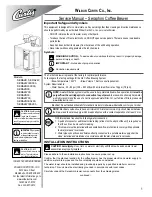
8976052
MINIMIG 100E Flux-Cored Welder
V4.0
20
For technical questions call 1-800-665-8685
1.
Connect the ground clamp to a scrap piece of metal that matches the
material that you are welding. It should be equal to or greater than the
thickness of the actual workpiece and free of oil, paint, rust, etc.
2. Select a heat setting.
3.
Hold the torch in one hand, allowing the nozzle to rest on the edge of the
workpiece farthest away from you and at an angle similar to one that will
be used when welding.
4.
With your free hand, turn the Wire Speed Dial to maximum and continue
to hold onto the knob.
5.
Lower your welding helmet and pull the trigger on the torch to start an
arc, then begin to drag the torch toward you while simultaneously turning
the Wire Speed dial counterclockwise.
6. Listen for a high–pitch buzzing sound. This indicates the setting is correct.
When decreasing the speed, the arc’s sound will change from a sputtering
noise to a high-pitched buzzing sound. It will begin sputtering again if you
decrease the wire speed too much.
You can use the wire speed control to slightly increase or decrease the heat
and penetration for a given heat setting by selecting higher or lower wire
speed settings. Repeat this tune-in procedure if you select a new heat setting, a
different diameter wire or a different type of welding wire.
DUTY CYCLE
The welding unit’s duty cycle rating defines how long the operator can weld
before allowing the welding unit to cool. The duty cycle is a percentage of a 10-
minute period. The welding unit must cool for the remainder of the cycle. This
welding unit has a duty cycle rating of 20% at the rated output (see
Specifications). This means that the user can weld for 2 minutes and then rest
the welding unit for 8 minutes before using it again.
The welding unit may stop before the 2-minute duty cycle time limit. Reduce
the wire speed slightly and tune in the welding unit at the lowest wire speed
setting that still produces a smooth arc. Welding with the wire speed set too
high causes excessive current draw and shortens the duty cycle.
INTERNAL THERMAL PROTECTION
Constantly exceeding the duty cycle can damage the welding unit. An internal
thermal protector will open when the duty cycle is exceeded, shutting OFF all
welding unit functions except the cooling fan. Leave the welding unit turned
ON with the fan running. The thermal protector will automatically reset and the
welding unit will function normally again once it has cooled.
















































